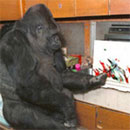 Introduction to Archaeology
and Palaeoanthropology:
Introduction to Archaeology
and Palaeoanthropology:
 Introduction to Archaeology
and Palaeoanthropology:
Introduction to Archaeology
and Palaeoanthropology:
Humanity's Journeys
Dr. Kathryn Denning
Anth 2140, Sept 2006 - Apr 2007
7 Nov 2006... Welcome!
Plan for class
1) Announcements
2) Primate behaviour revisited
3) Hominid evolution... from the beginning. Australopithecines! Excerpt from video, The Story of Lucy
Announcements:
Reading assignment for next week - continuing with human evolution.
In tutorial tomorrow: assignments and quizzes will be returned, you'll watch more of The Story of Lucy, and you'll look at some fossil casts.
If you are interested in an accelerated credit next term: The Anthropology Department is offering the 6 unit course, Anth 1110 (Introduction to Social Anthropology), next term. Tues AND Thurs 8:30-11:30, with Dr. Zulfikar Hirji. Projected enrolment: 50. n.b. ANTH 1110 is a required course for Anthro majors.
We need a note-taker for this class, who is at least a B+ student, and who also has good notes going back to the start of term. N.B. This is a paid position, at $15/hour. To offer your services, please contact Elizabeth Kismatali <ekismat@yorku.ca> at the Counselling and Development Centre.
BACK TO NONHUMAN PRIMATES....


 Above
left: "Me, Myself, Good" - painting by Michael the gorilla, with his own
handprint.
Above
left: "Me, Myself, Good" - painting by Michael the gorilla, with his own
handprint.
Above Right: "Pink Pink Stink Nice Drink" - painting by Koko the gorilla. "Koko painted her own rendition of a photo she saw that contained a valley with a stream banked by beautiful pink flowers. 'Stink' is Koko's sign for flowers, 'drink' is her sign for water, and she named the painting herself."
Left: Koko. from http://www.koko.org
Reviewing key points about primate behaviour and what it can teach us
- primates are intelligent, sensitive, generally social creatures
- behaviour is tremendously diverse
- can teach us about primates for their own sake
- n.b. our knowledge is incomplete and always developing (e.g. with better observation methods or new methods of analysis)... old theories get thrown out or modified...
- studying primate behaviour can teach us about our own general primate heritage -- but beware of 'shopping' for primate evidence to support theories about human behaviour. (e.g. that we're naturally aggressive, naturally peaceful, naturally in nuclear families, naturally polygamous, normally heterosexual, that males naturally do this while females naturally do that, etc.) The evidence must be weighed very carefully. No easy answers. Be skeptical of arguments (e.g. in the media) which are based on just one species, or that seem to be one-sided.
- also be aware if searching for specific characteristics that make humans different from other primates -- for most, there are exceptions! Usually a matter of degree. (e.g. language, culture)
- ethical issues include rights/protections in captivity and research, severe endangerment in the wild
To proceed with studying hominid evolution, we need to know our way around the skeleton...
Orienting ourselves anatomically
Some key features on a human skeleton: frontal, parietal, mandible, maxilla, occipital, clavicle, ribs, humerus, femur, foramen magnum, incisors, canine, premolars, molars





A few key principles about hominoid & hominid evolution
challenges include these:
When we’re studying fossils: We have to contend with infrequent fossilization, fragmentary remains and the challenges of taphonomy (the changes that occur to organisms or objects after being buried or deposited), including scattering of remains, exposure to the elements, etc. Have to consider why things are found together (deliberate deposition, accidental coincidence, etc.)
- fragmentary, damaged, infrequent fossils, often without a population for comparison ... so it can be hard sometimes to decide whether a fossil is a new species, or a variant on an older one, or whether it's a male or female. Entire skeletons are quite rare.
- this means there's a lot of room for differences of opinion, and different names for the same fossil... usually when a new type of fossil is found, it takes a few years for consensus about it to emerge
- new finds rewrite the taxonomies, quite often... also, you can 'lump' or 'split' (see p 115)
- we can sometimes get DNA out of semi-fossilized bone, but this is rare and only recently possible. Can't get DNA from something completely fossilized. No DNA yet for australopithecines... but they're working on Neanderthal DNA now.
n.b. sometimes there are disputes about DNA analyses.... e.g. what the oldest DNA retrieved is. (Sometimes scientists make announcements but other scientists can't confirm their results)
- dating can be a challenge. Potassium argon dating is the primary method used for dating hominid fossils, but note -- this is dating the volcanic rock layers above or below the fossil, rather than the fossil itself.
[Radioactive potassium decays to argon gas... so we can only use this method on minerals which contain potassium and then trap the argon gas so that we can measure it. Volcanic tuff (compressed ash) has this chemical composition... and there's lots of it in East Africa, which is handy for hominid dating.]
Date range for K-AR - from 250 000 years ago back to the origins of life.
We can also use C14 dating, but that's for later specimens (not fully fossilized), from about 40 000 BP until present.
Note regarding dates/terminology:
mya = million years ago (or, myr ago)
kya = thousand years ago
BP = before present
BC = Before Christ = BCE = Before Common Era
AD = Anno Domini = CE = Common Era
Have a hard time converting these? Think about a timeline...

Or think about a clock. If it's 1 am now.... how long ago was 7 pm?

Or if it's 6 am now... how long ago was 11 pm?

Also recalling -- how do we picture evolution taking place?
The "March of Progress" iconography... this is not how things happened.

Below, is a better way of representing human evolution.
.. we have many different specimens (these are just a few), and although we can group them approximately with a high degree of confidence, we can't trace a single line of human evolution.

And also recalling... something important about adaptations.
there is variability in any population, and various evolutionary forces then affect the prevalence of different traits. (forces including natural selection, sexual selection, genetic drift, mass extinction events, etc.)
but note! according to standard evolutionary explanations: the variability doesn't arise "for a reason", i.e. there's no big plan or direction for evolution. So, for example, our primate ancestors began to develop nimble hands... but they didn't develop nimble hands so that we could later hold a pencil. They started to develop nimble hands, which proved to be an advantage in a certain environment, and then also turned out to have additional uses later on.
So we didn't evolve nimble hands for the purpose of playing the piano or firing a gun or typing on a keyboard, but it turns out that these are things we can do with our hands.
Similarly, we didn't develop a suspensory shoulder joint so that we could play baseball... it's a left-over feature from our earlier primate heritage. But even though we don't swing through the trees (much) anymore, it came in handy for other things -- like throwing things... rocks, spears, hand grenades, etc.
Human evolution overall
Becoming Human (Flash) http://www.becominghuman.org/
(Anatomy... hominid profiles)
Hall of human ancestors http://www.mnh.si.edu/anthro/humanorigins/ha/catalog.htm
Historical development of Understanding of Human Evolution
It has long been realized that the key trends in human evolution, i.e. the things that separate us from our ape cousins and ancestors, were...
terrestriality - coming down out of the trees
bipedalism - having to walk on two feet (obligate, not occasional)
encephalization - increase in brain size in relation to body, development of language
civilization - complex technology, moral systems, complex society
But in the earliest days of studying human evolution (up to 1920s), it wasn't known which came first...
- there weren't enough fossils, they weren't well understood, and they weren't securely dated
- Arthur Keith 1895 "Only four individuals to represent the millions and millions of men that must have lived and died in Quaternary times!" (German Neanderthal skull, Pithecanthropus from Java, two Cro-Magnon Belgian skulls) (As opposed to now, when we have MANY)
- so different theories were abundant

This is why the Piltdown forgery worked.... people at the time wanted to believe that big brains came before other human traits, so a big-brained 'fossil' with an ape's jaw fit their preconceptions.
Now, we know that's not what happened... Our brains were still pretty small when we became bipedal.
Orienting ourselves in terms of Biological and Early Cultural Trends: locomotion, brain, teeth, and tools
Although there are occasionally some very interesting and extremely surprising new finds, the general contours of human evolution are now well-drawn.

TRENDS in hominid evolution: bipedalism, expansion of brain (cranial capacity), brain complexity, modification of female pelvis, reduction of teeth, face, and jaws, extended period of infant and child dependence, hairlessness...and eventually, apparent increased reliance on meat, emergence of tool use etc.
Bipedalism - changes in knee, foot (esp big toe), pelvis, spine curvature
Early hominids in general had 3 major adaptive problems - being large mammals, terrestrial primates, living in an open, savanna environment
Bipedalism might have been an advantage because: increased ability to see predators and prey, free hands for carrying food and infants, tool use, long distance traveling more efficient. But it does have drawbacks, too... e.g. if you injure one foot. And it's a strain on hips, backs, knees, ankles.
Textbook p 111 suggests that the best hypothesis for the origins of bipedalism is energy-efficiency, and thermo-regulation (maximum breeze, minimum exposure of body surface to sun at noon)
made it to here in class on the 7th
Cranial capacity: Australos - 380 to 550 cc, vs. early Homo 630-640, vs. Homo sapiens sapiens (us!), usually 1300+ cc N.B. this does vary with body size, and the simple size of the brain alone does not mean greater intelligence within a species. Bigger and more complex brains - linked to stone tool making? around 2.5 mya (Oldowan tool industry),
Pre-australo species
Orrorin tugenensis.... around 6 myr
Sahelanthropus tchadensis – Toro-Menalla region of Djurab Desert in Chad, Central Africa, 6-7 mya
Australo Species: new ones being discovered all the time! Most hominid fossils found in Great Rift Valley of East Africa, and also in South Africa. (Ethiopian, Tanzania, Kenya, and S. Africa)
Additional recent finds: A. anamensis, A. garhi, etc.
Gracile: A. africanus (Taung child) was an early discovery, A. afarensis (Lucy) was a big find in the 70s (40% of skeleton!)
Australopithecus africanus – 3 to 2.5 mya, found by Raymond Dart in 1925 at Taung, South Africa
Australopithecus afarensis – about 3.2 mya, Maurice Taieb and Donald Johanson, Hadar, Ethiopia [well, actually, a student named Tom Gray], nicknamed “Dinkanesh” or “Lucy”, pretty clearly bipedal... though some arboreal traits
Laetoli footprints - 3.5 mya, australo, by Mary Leakey
Robust australos: (Paranthropus/Australopithecus boisei, robustus, aethiopicus)
Special note: the debates over species names and relative positioning are heated. Esp. Johanson and Leakey camps.
NEW FIND: "Lucy's Baby" -- couldn't have been her baby, but anyway, a juvenile Australopithecus afarensis, also known as the "Dikika baby". Announced this year. 3.3 million years old, about three years of age. Very rare to find juvenile hominid fossils, and this one is quite complete:
http://www7.nationalgeographic.com/ngm/0611/feature6/index.html
http://www.nature.com/nature/focus/hominiddevelopment/index.html#video
Specimen images: http://www.nature.com/nature/journal/v443/n7109/full/nature05047.html
N.b. compare the Dikaka fossil specimen and the popular 'face'
Key features of australopithecines
p 121
- large degree of sexual dimorphism
- cranial capacity c 500 cc
- bell-shaped occipital region
- moderate to large eyebrow ridges
- marked post-orbital constriction
- flaring zygomatic arches
- large face relative to size of brain case
- relatively large and jutting jaw
- no chin
- large/very large premolars and molars, thick enamel, small canines
- bipedal
- bowl-shaped pelvis
- life expectancy 44 years (?)
- opposable thumbs
-------------------
Homo species: bigger brains, reduced molars and premolars
2.5 mya onwards: Homo habilis (Olduvai)
Earliest tools seem 2.5 mya but dispute over who made them (A? H?) -- Oldowan tradition, chopper tools and flakes, pretty basic but very useful for cutting plants and also meat (n.b. we only have stone tools -- and what else might they have used?)
1.7 to 1.5 mya: Homo erectus emerges - significant because these are the first found out of Africa, in Europe and Asia (some have reclassified the African ones as H. ergaster). Early-discovered specimens: 'Java Man', 'Peking Man'. Bigger brain (895-1040 cc), different brain proportions, and larger overall body size (like us). Prominent, projecting brows. Very dense thigh bones. Developed Acheulean tool tradition from 1.5 mya. Clear evidence of big game consumption (hunting? scavenging?) Potential use of fire 1.4 mya, definite use and control of fire for cooking 500 000 BP in China. Also apparent use of basic structures. Language? Could be. Looks like their brains were up to it, at a basic level.
Archaic Homo sapiens
Considerable continuity between H. erectus and archaic H. sapiens in some place....hard to draw the line. (still, decreasing jaw, face, back teeth, cranial capacity)
Special notes about interpreting the fossil and archaeological record
We have to be careful about over-interpreting.... we need to be very aware of the limitations of our data.
e.g. we know that early hominids made stone tools. But there may have also been wooden tools that didn't survive.
e.g. we know that some early hominids ate meat, because we've found animal skeletons that clearly have butchering marks on the bones, from stone tools. BUT we don't know for sure whether they killed or scavenged. And we don't know directly what else they ate, because, for example, fruits don't leave behind skeletons. We can make inferences based on tooth wear, however. We can also make inferences based on the technology (e.g. you can't use an Acheulian handaxe as a throwing spear... )
e.g. when trying to understand social behaviour... we must be careful not to simply project present or recent human behaviour back into the past, or to use primate examples very literally. For example, if you want to make guesses about the social structure of Australopithecus afarensis:
- they're dimorphic in terms of overall size - which suggests that their social structure would be like gorillas (one dominant male, multiple females)
- but! their canines are not dimorphic, which suggests a social structure like gibbons (monogamous)
So we don't, and presently can't, know their mating patterns and social patterns.